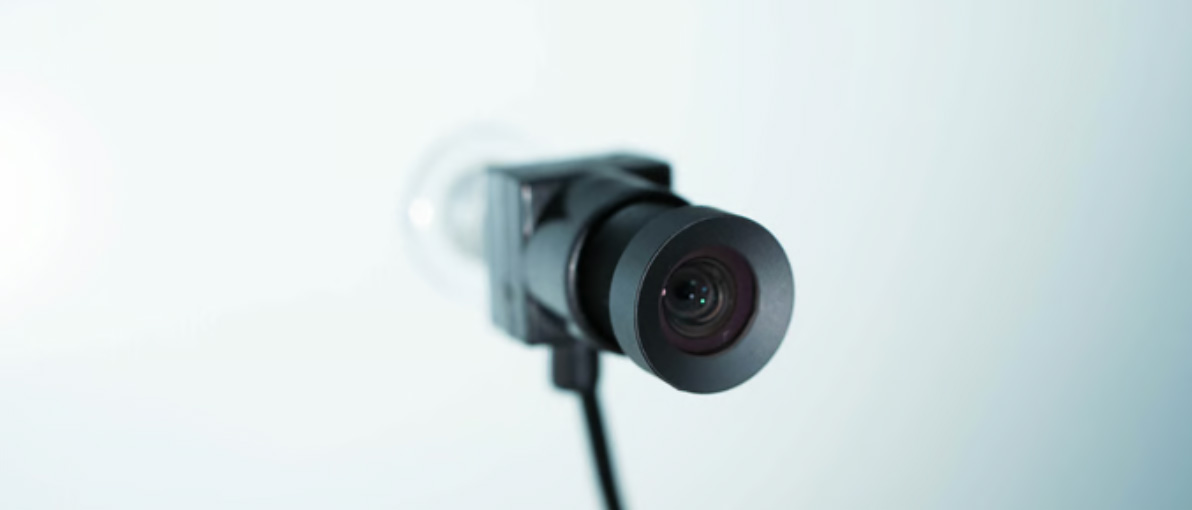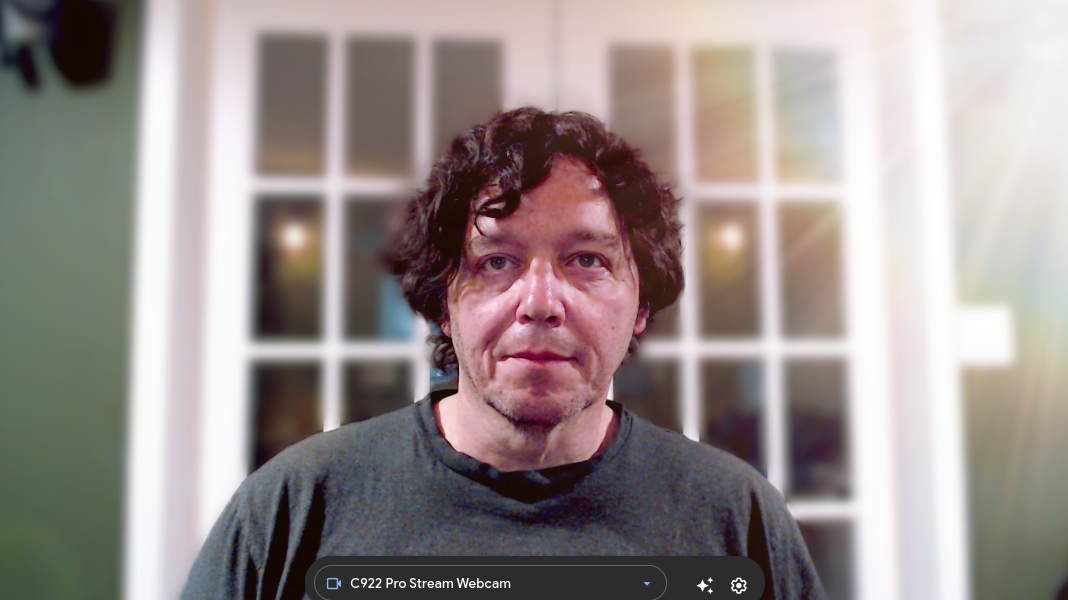Eye to Eye Cam Review: Not quite the solution to 'gaze glitch' but a small step in the right direction
A video camera that gets front and center when you need it - and out of the way when you don't

-
+
Small and unobtrusive
-
+
Stow easily with handy hangers
-
+
2MP camera creates passable image
-
+
Works out of the box
-
-
Can detach from screen if not firmly affixed
-
-
Sucker can leave screen residue
-
-
Hollow-sounding microphone
-
-
No companion software
-
-
No 5x digital zoom as described
-
-
Poor low-light performance

If you're at a social gathering and someone looks right past you while you're talking to them, you'd probably be quite put out. So why do we put up with it during video conferences all day? Whether you're in Teams, Zoom, or Webex, you'll often see people staring slightly off-center while you thrill them with your hot take on the quarterly sales figures.
Don't worry. It's not you. Well, it might be you. If they take long blinks and close their eyes for extended periods, it's definitely you. Nevertheless, there's also something else going on. Here at ITPro, we call it gaze glitch, and it's a problem with the way that webcams and screens interact.
Screens are getting bigger. They're now so large that they look like parodies of themselves. The cameras we perch atop these giants are further away from the center of the screen, which is where you typically look when you're speaking with someone.
Things get worse for those of us who use our screens in portrait mode. The 27-inch monitor we used for this review – modest by today's standards - looks like the monolith from 2001: A Space Odyssey perched vertically on our desk. We can fit this whole article on it, which is great for us, but not so great for the person talking to the top of our head during a Google Meet session.
Laptops are better, but you still often have to sit back from them for glaze glitches not to be obvious. Also on some models (notably the earlier Dell XPS 13 machines or the Huawei MateBook 16), the cameras were at the bottom of the screen, creating a delightful nostril-cam effect.
The tech industry has tried some outrageously over-engineered solutions. Apple introduced Facetime Attention Correction (later Eye Contact) in iOS 13 to digitally adjust your eyes in Facetime calls. Nvidia introduced a vaguely terrifying Eye Contact feature that uses AI to redraw the user's gaze, artificially directed toward the camera, in real-time. As if things in real life weren't weird enough without tech companies plunging us into the uncanny valley.
Eye to Eye Cam: What is it?
Sometimes it feels like the simpler solution is the easiest. That's where the Eye to Eye Cam 3 comes in. This is a low-tech solution to a high-tech problem. Instead of using AI shenanigans to fix your gaze in the right place, it simply puts the webcam into the middle of the screen.
The Eye to Eye Cam 3 is a small, unobtrusive device that you can affix to the center of the screen using a lick-and-stick adhesive sucker.
RELATED WHITEPAPER

This isn't the first shot at a center-mounted camera. There's the Center Cam, which is a clip-on system with a flexible tube that you can bend into shape. Another gadget, the PlexiCam, hangs over your screen and sports a small shelf to hold your existing webcam in place. That seemed too obtrusive (and at a minimum of around £65, pretty expensive for a piece of clear plastic).
The Eye to Eye Cam 3 was on sale for the U.S. equivalent of around £85, down from around £120, but unlike the Plexicam you don't need to buy a webcam to go with it. it uses a simple USB cable rather than the Center Cam's thicker, less malleable flexitube. This makes it thinner, blocking less of the screen.
Eye to Eye Cam: Usage
Intended for both laptop screens and desktop monitors, the Eye to Eye Cam 3 comes in a handy semi-rigid carry case with some accessories: two suckers, which the camera screws into, along with stick-on cable holders so that you can anchor the camera to the rear of your monitor.
Affixing the camera to your precious monitor screen might seem unnerving, but even a solid push won't hurt your display. You'll need to affix it well. When we didn't it came loose and swung wildly around during the middle of a video conference.
The cable and camera are not obtrusive during video calls but you'll still want it out of the way when you're not using it. If you've done a good job of securing the sucker, you'll need to pry it off the screen. We did this and noticed residue on our monitor. It's nothing a quick wipe with a cloth didn't fix, but it's worth noting. This is an area where something like the Center Cam excels because you don't need it to touch the screen at all.
Eye to Eye Cam: Performance
Perhaps the best thing about this tiny little camera is its auto-focus capability. This means there's no messing around with focusing software or bezel dials. You plug it in, stick it on, and you're up and running. There's a tiny camera cover for it to preserve your privacy when you're not conferencing.
So how's the picture? The device has a 78-degree viewing angle, which works well for video conferencing. As its manufacturer, Shenzhen Yiyoujiapin Network Technology Co, states on the camera's website, it is a 1080p unit delivering 30fps. Confusingly, the instruction manual that comes with the webcam says that it also supports 4K video (it doesn't).
The lack of 4K support didn't bother us. Zoom and Teams automatically downscale 4K video to 1080p anyway. We've used 4K cameras and don't see the point unless you're going to be recording video content, in which case you'd want a more professional setup – even a DSLR or mirrorless camera - with a larger lens.
The specifications both on the website and in the manual mention a 5x digital zoom, we couldn't find that at all. The device's companion software was no help, because there wasn't any, but two third-party camera apps on two different operating system platforms couldn't help.
Quality-wise, the Eye to Eye Cam 3 performed relatively well in normal lighting:

It holds up pretty well to this 1080p Logitech C920S Pro:

But when you're working with low lighting, the difference becomes obvious. Here's the Logitech:

And the Eye to Eye Cam 3 in low light was disappointing:

The omnidirectional stereo microphone on the device sounded muffled, which is to be expected on a camera not much bigger than your thumbnail with an embedded mic. We'd recommend using a headset/earbud mic or a dedicated podcasting mic for rock-solid sound.
Eye to Eye Cam: Is it worth it?
The Eye to Eye Cam is a mediocre solution, especially for the money. The questionable product handling didn't inspire confidence, from the inconsistent specifications in its manual through to the computerized voice on the website's promo video, and a link to "Product support"[sic]. Nevertheless, the camera performs well enough as long as your lighting conditions are optimal. We wanted a small camera with decent video that solves the gaze glitch problem quickly and easily. From that perspective, it does what it promises.
Get the ITPro daily newsletter
Sign up today and you will receive a free copy of our Future Focus 2025 report - the leading guidance on AI, cybersecurity and other IT challenges as per 700+ senior executives
Danny Bradbury has been a print journalist specialising in technology since 1989 and a freelance writer since 1994. He has written for national publications on both sides of the Atlantic and has won awards for his investigative cybersecurity journalism work and his arts and culture writing.
Danny writes about many different technology issues for audiences ranging from consumers through to software developers and CIOs. He also ghostwrites articles for many C-suite business executives in the technology sector and has worked as a presenter for multiple webinars and podcasts.
-
 Cleo attack victim list grows as Hertz confirms customer data stolen – and security experts say it won't be the last
Cleo attack victim list grows as Hertz confirms customer data stolen – and security experts say it won't be the lastNews Hertz has confirmed it suffered a data breach as a result of the Cleo zero-day vulnerability in late 2024, with the car rental giant warning that customer data was stolen.
By Ross Kelly Published
-
 Women show more team spirit when it comes to cybersecurity, yet they're still missing out on opportunities
Women show more team spirit when it comes to cybersecurity, yet they're still missing out on opportunitiesNews While they're more likely to believe that responsibility should be shared, women are less likely to get the necessary training
By Emma Woollacott Published
-
 OpenAI wants developers using its new GPT-4.1 models – but how do they compare to Claude and Gemini on coding tasks?
OpenAI wants developers using its new GPT-4.1 models – but how do they compare to Claude and Gemini on coding tasks?News OpenAI says its GPT-4.1 model family offers sizable improvements for coding, but tests show competitors still outperform it in key areas.
By Ross Kelly Published